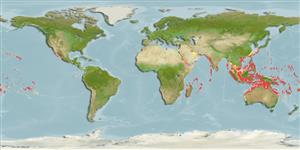Environment: milieu / climate zone / depth range / distribution range
Écologie
marin récifal; profondeur 1 - 65 m (Ref. 90102). Tropical; 32°N - 32°S
Indo-Pacific: Mauritius and the Cargados Carajos Shoals and Sri Lanka to French Polynesia (Moorea and Scilly Atoll); north to Japan; south to Australia.
Taille / Poids / Âge
Maturity: Lm ? range ? - ? cm
Max length : 8.6 cm SL mâle / non sexé; (Ref. 1602)
Épines dorsales (Total) : 7 - 8; Rayons mous dorsaux (Total) : 19 - 22; Épines anales: 3; Rayons mous anaux: 15 - 18; Vertèbres: 25 - 27. Brownish with dusky reticulations (Ref. 6635). No dermal flap or small tentacle dorsally on eye. Two large pores in interorbital space, one on each side close to the edge of the orbit. Tubular anterior nostril near the edge of the snout at the base of the upper lip, the tube is not long; when laid back reaching almost half way to posterior nostril. Second lateral line not fully developed. Longitudinal scale series 46-50(Ref. 27020).
Secretive (Ref. 48635); lives among corals of shallow reef flats and lagoons (Ref. 1602). Also found under dead coral pieces but quickly sneaks away when looking underneath (Ref. 48635). Solitary (Ref 90102).
Life cycle and mating behavior
Maturities | Reproduction | Spawnings | Egg(s) | Fecundities | Larves
Randall, J.E. and C.C. Baldwin, 1997. Revision of the serranid fishes of the subtribe Pseudogrammina, with descriptions of five new species. Indo-Pac. Fish. (26):56 p. (Ref. 27020)
Statut dans la liste rouge de l'IUCN (Ref. 130435)
Menace pour l'homme
Harmless
Utilisations par l'homme
Outils
Articles particuliers
Télécharger en XML
Sources Internet
Estimates based on models
Preferred temperature (Ref.
123201): 24.5 - 28.9, mean 27.5 °C (based on 746 cells).
Phylogenetic diversity index (Ref.
82804): PD
50 = 0.5001 [Uniqueness, from 0.5 = low to 2.0 = high].
Bayesian length-weight: a=0.00427 (0.00166 - 0.01096), b=3.17 (2.94 - 3.40), in cm total length, based on LWR estimates for this (Sub)family-body shape (Ref.
93245).
Niveau trophique (Ref.
69278): 3.7 ±0.5 se; based on size and trophs of closest relatives
Fishing Vulnerability (Ref.
59153): Low vulnerability (10 of 100).
Nutrients (Ref.
124155): Calcium = 122 [66, 266] mg/100g; Iron = 0.756 [0.375, 1.442] mg/100g; Protein = 17.9 [16.0, 19.6] %; Omega3 = 0.128 [0.069, 0.246] g/100g; Selenium = 29.2 [12.7, 65.5] μg/100g; VitaminA = 167 [47, 646] μg/100g; Zinc = 1.72 [1.05, 2.67] mg/100g (wet weight);
